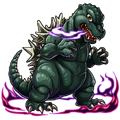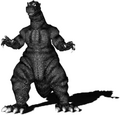Template:Tabber2Showa
The 1954 Godzilla (ゴジラ Gojira?) is a daikaiju created by Toho that makes its first appearance within the 1954 Godzilla film, Godzilla.
This Godzilla was later succeeded by a second Godzilla during the events of the 1955 film, Godzilla Raids Again and the rest of the Showa series.
This incarnation of Godzilla was also referenced in, and appeared within the Millennium series of Godzilla films.
Name
The name "Godzilla" is a transliteration of Gojira (ゴジラ?), a combination of two Japanese words: gorira (ゴリラ?), meaning gorilla, and kujira (鯨 or クジラ), meaning whale. At one planning stage, the concept of "Gojira" was described as "a cross between a gorilla and a whale." The two words "whale" and "gorilla" describe Godzilla's traditional characteristics.
Since Godzilla is neither a gorilla nor a whale, the name had to be devised in a different way for the original film's story. Godzilla's name was originally spelled in kanji as 呉爾羅 by the Odo Island natives. However, Toho chose these characters for sound only, as the combined characters mean "give you net."
Before Toho sold the film to U.S. distributors, Toho's international division had originally marketed an English-subtitled print under the title of Godzilla, King of the Monsters!, which was shown briefly in Japanese-American theaters. Toho came up with "Godzilla" as an English transliteration of the name "Gojira"."
Appearance
ShodaiGoji
The ShodaiGoji design is the designation for the 1954 kaiju's design. This suit featured a heavy lower body, small arms and a large, round head. The face had pronounced brows while the eyes were completely round with tiny pupils, a feature unique to this costume.
For close-up shots, a hand-held puppet and the prototype suit were used. As a result, when the camera focuses on Godzilla's head in such close-ups, such as when he is firing his atomic breath, Godzilla appears to have larger, more glossy-looking eyes.
The suit also included several features particular to itself and to the 1955 incarnation, the GyakushuGoji: fangs, four toes, a rough underside for the tail and pointed tail tip, and staggered rows of dorsal plates. These features would reappear with the Heisei and Millennium series of Godzilla films from 1984 to 1999. The dorsal plates for both the ShodaiGoji and the GyakushuGoji were dynamic in design and unique to the two costumes. During filming, a separate pair of Godzilla legs were used for close-up shots of Godzilla's feet.
The ShodaiGoji was recreated through computer generated imagery and a large puppet for new flashback scenes in Godzilla Against Mechagodzilla in 2002, namely where the original Godzilla is shown being reduced to a skeleton by the Oxygen Destroyer rather than completely disintegrated as in the original film.
Portrayal
The ShodaiGoji suit was the first of its kind - being fully operated by a man inside of it. As there were no established procedures on how to build or operate a suit like the original Godzilla suit, Godzilla special effects artist Eiji Tsuburaya and the production staff had to pioneer a new technique that would later be known as suitmation.[2] The ShodaiGoji suit and the original pre-ShodaiGoji suit were built by Eizo Kaimai.
The ShodaiGoji was portrayed by Haruo Nakajima, who would go to portray Godzilla in almost every subsequent film up to Godzilla vs. Gigan. Nakajima has said that he made Godzilla walk like an elephant from observations he made by watching an Indian elephant called "Indira" back around the time of Godzilla's production,[3] so that Godzilla would not look vulnerable and to portray his massiveness.[4] According to Nakajima, temperatures inside the suit reached up to 60 degrees Celsius, and he couldn't move Godzilla's left hand whatsoever in the ShodaiGoji suit.
Roar
Godzilla's roar is a famous sound effect. Over the years, it has changed considerably, sounding different almost every time and having many variations for the different emotions.
The sound effects team originally tried to create Godzilla's roar by using animal roars that had been edited. They sampled all kinds of birds and mammals, but nothing seemed to be the right match for the reptile-like noises a monster like Godzilla would make. Akira Ifukube, who was the film's composer, proposed stepping away from using animal samples. He then took a string off of his contrabass and rubbed it with gloves soaked in pine tar. The sound that came from it was used as Godzilla's roar.
This roar would later be altered for use as the roar of other monsters in the Showa era, including Varan, Baragon and Gorosaurus. Godzilla's roar was increased in pitch starting in King Kong vs. Godzilla, and would remain mostly unchanged for the rest of the Showa series.
Personality
Godzilla, in the original Godzilla film, is a creature whose underwater habitat was completely destroyed by a hydrogen bomb test which killed his entire family and left him burned and scarred, ultimately mutating him. Enraged and driven from his home, Godzilla took out his rage upon humanity, destroying any boats that he encountered and later laying waste to the city of Tokyo, sparing no one.[5]
Origins
In the original 1954 Godzilla film, it is proposed that Godzilla was a type of prehistoric intermediary reptile related to both land and sea reptiles that slept deep underwater for millions of years feeding on deep sea organisms before being disturbed and enhanced by an American hydrogen bomb test. Dr.Yamane proposes that the original Godzilla might have been living among others of his kind prior to the detonation, but the H-bomb completely destroyed his home and drew him out.
This idea is supported by official artwork of the 1954 Godzilla living with other Godzilla's underwater before a huge explosion destroys his habitat, killing his companions and burning and enraging Godzilla and drawing him out to the surface.
History
Showa era
Godzilla
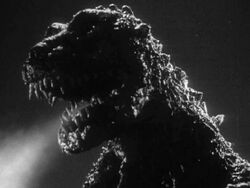
Following an American hydrogen bomb test in the Pacific Ocean, a giant prehistoric reptile was disturbed from its underwater slumber and heavily irradiated. The monster began attacking various ships in the waters off Japan, prompting a search party to be sent to Odo Island, where some of the survivors had washed ashore. The islanders believed the shipwrecks were caused by Godzilla, a giant sea monster from their folklore which they believed would come ashore to feed on humanity. One night, a typhoon struck the island, leaving it devastated. However, it was apparent most of the damage was caused by something other than a typhoon, as houses in the village appeared to have been crushed from above. A research team headed by Kyohei Yamane was sent to the island, and discovered a giant radioactive footprint on the island, with a Trilobite embedded in it. Suddenly, the monster that was responsible for the shipwrecks and the damage on the island appeared over a hill on the island. The people fled, realizing the creature was 50 meters in height.
Back in Japan, Yamane named the creature "Godzilla" after the monster from Odo Island folklore, and proposed it was a transitional organism from the Jurassic Period, related to both land-living dinosaurs and sea-dwelling reptiles. Yamane believed that Godzilla was exposed to a recent American H-bomb test, hence the radiation found in his footprint, and stressed the monster should be studied to see how he survived to this point. The J.S.D.F. sent battleships to destroy Godzilla with depth charges, declaring him dead. However, Godzilla soon surfaced in Tokyo Bay completely unharmed, plunging Japan and the international community into a state of emergency. One night, Godzilla came ashore in Tokyo, destroying the outskirts of the city before returning to the bay. In response, the J.S.D.F. erected a barrier of power lines around the heart of Tokyo, with 300,000 volts of electricity passing through them, in the hopes they would halt Godzilla. When Godzilla came ashore again one night, he tore through the power lines and melted them with a beam of radioactive heat fired from his mouth. The J.S.D.F. fired on Godzilla with artillery, but their weapons had no effect. Godzilla proceeded into downtown Tokyo, transforming the Japanese capital into a sea of flame overnight. With his rampage concluded, Godzilla returned to the bay, where he was attacked by F86F Sabre fighter jets before finally disappearing beneath the waves.
In the aftermath of Godzilla's raid, Tokyo was an uninhabitable wasteland, burned to a crater and contaminated with deadly radiation. The Japanese government was at a loss in combating the monster and preventing future attacks. Scientist Daisuke Serizawa was approached by his former fiance Emiko Yamane and her boyfriend Hideo Ogata, who asked for him to use his experimental chemical weapon, the Oxygen Destroyer, against Godzilla. Serizawa was horrified by the idea of revealing his invention to the world and refused at first, but was convinced after watching a television program showing Japanese schoolchildren singing a song praying for peace. Serizawa burned his notes on the Oxygen Destroyer and handed it over to the J.S.D.F.
A boat was sent to Tokyo Bay, using a Geiger counter to locate Godzilla underwater. Serizawa and Ogata donned diving suits to go underwater and detonate the device. Once they reached Godzilla, who was asleep on the ocean floor, Ogata was pulled to the surface while Serizawa severed his line and activated the device, sacrificing his own life to stop Godzilla and prevent his weapon from ever falling into the wrong hands. After a few moments, Godzilla rose to the surface and roared defiantly at the boat before sinking under the waves to his death. While the people on the boat both celebrated Godzilla's demise and mourned Serizawa's sacrifice, Dr. Yamane solemnly warned that it was unlikely Godzilla was the last member of his species, and that if mankind continued nuclear testing, another Godzilla would almost certainly appear.
Godzilla Raids Again
Following Godzilla's death, footage of the monster's attack would be revealed during a discussion on how to stop the newly risen Godzilla.
Millennium series
Although the 1954 Godzilla died in the original Godzilla film of the Showa era, its fate would later be rewritten in the Millennium series of films.
Godzilla vs. Megaguirus
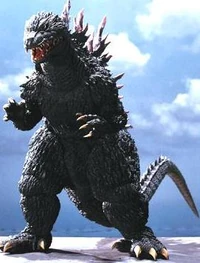
In 1954, Godzilla raided Tokyo and reduced the city to a smoldering wasteland in one night. Afterward, Godzilla slipped back into Tokyo Bay and disappeared beneath the waves. The damage was so great that Japan's capital was moved to Osaka. Japan endured a decade of rebuilding, eventually embracing nuclear power and gradually putting Godzilla's attack behind them. But in 1966, Godzilla returned and attacked the Tokai Nuclear Power Plant, feeding on the nuclear reactor. The Japanese government concluded that nuclear power was what attracted Godzilla, so all of the country's nuclear plants were shut down. Japan struggled to find alternate energy sources, but nothing proved able to replace nuclear power. In the 1990's, a breakthrough was made in the form of plasma energy. This clean, non-nuclear power source appeared to be the future of Japanese energy. But in 1996, Godzilla was attracted to the plasma reactor in Osaka, deciding to feed on it in the absence of nuclear energy. A team of J.S.D.F. soldiers were deployed to stop Godzilla, but they were massacred. The lone survivor of the operation was Major Kiriko Tsujimori, who went on to become a founding member of the J.S.D.F.'s elite anti-Godzilla unit, the G-Graspers. By 2001, plasma energy was banned in Japan, and the G-Graspers had developed the ultimate anti-Godzilla weapon, a miniature black hole gun called the Dimension Tide. The Dimension Tide was test-fired in the outskirts of Tokyo, where it completely absorbed an abandoned building. The G-Graspers were certain the Dimension Tide would do the same to Godzilla, and the weapon was mounted on a satellite while the G-Graspers searched for Godzilla. Godzilla was discovered in the waters off Japan, and the GX-813 Griffon was sent to lure him ashore at Kiganjima. The Dimension Tide was prepared and aimed at Godzilla, but suddenly a swarm of giant prehistoric dragonflies called Meganula flew overhead and attacked Godzilla, draining his energy with their tails. Godzilla killed most of the Meganula with his tail and atomic breath, and the Dimension Tide was fired at him. However, the weapon merely buried Godzilla under a pile of rubble, and he quickly got up. Godzilla waded out to sea and vanished.
Shortly afterward, Godzilla came ashore in Tokyo Bay, heading directly for the science institute. En route, he was attacked by Megaguirus, the Meganula queen which had been mutated by the energy her swarm drained from Godzilla. Megaguirus attacked Godzilla near the Tokyo Telecom Center, easily avoiding his attacks and landing several of her own due to her incredible speed. After managing to slice off Megaguirus' claw with his dorsal plates, Godzilla turned the tide of battle when he caught Megaguirus' tail and stuck it into the ground. Godzilla jumped into the air and body-slammed Megaguirus. Megaguirus flew at Godzilla, aiming her stinger at his head, but he caught it in his mouth and bit it off. Megaguirus reeled back in pain, as Godzilla fired his atomic breath directly at her, causing her to erupt in flames before crashing to the ground and exploding. His enemy defeated, Godzilla reached the science institute and uncovered a hidden plasma reactor. While Godzilla was distracted, the Dimension Tide was fired at him. However, the satellite fell out of the atmosphere and was approaching Tokyo. Tsujimori used the Griffon to allow the Dimension Tide to lock on Godzilla's location, then ejected as soon as the weapon fired. When the smoke cleared, Godzilla had disappeared without a trace. Godzilla appeared to be finally gone, and the nation of Japan rejoiced.
A few weeks later though, the G-Graspers began to detect a series of tremors underneath Tokyo, and contemplated the possibility that Godzilla was merely pushed underground by the Dimension Tide like before. These fears were confirmed when Godzilla emerged from underground in Tokyo, roaring menacingly.
Godzilla, Mothra and King Ghidorah: Giant Monsters All-Out Attack
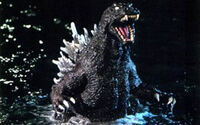
Godzilla in Godzilla, Mothra and King Ghidorah: Giant Monsters All-Out Attack
In 1954, Godzilla emerged and attacked Tokyo, transforming it from the capital of Japan to a nuclear disaster zone overnight. Godzilla was killed with an experimental chemical weapon developed by a scientist who took his own life to prevent the weapon from being used again. In order to avoid facing ridicule for failing to stop Godzilla and ensure the citizens of Japan they were safe from future attacks, the J.S.D.F. claimed credit for killing Godzilla. Godzilla's body was not disintegrated by the chemical weapon, but remained to be revived by the vengeful spirits of the dead from World War II.
Over the next several decades, humanity gradually began to forget about Godzilla, with many assuming the creature never existed and was simply a legend. In 1998, a giant reptilian monster attacked New York City, with American experts identifying the creature as Godzilla. The J.S.D.F. doubted that the monster was Godzilla, but could not ignore the appearance of another giant monster. In the years following the New York attack, sightings of giant monsters skyrocketed around the world, forcing the J.S.D.F. to be on high alert for the possible return of Godzilla. In 2002, an American nuclear submarine vanished off the coast of Guam. The Japanese research submersible Satsuma investigated the wreckage, noticing huge claw marks in the sub's hull. Just then, the ground shook, causing the Satsuma's sister craft to crash into a rock. Just then, the vessel's pilot witnessed Godzilla's dorsal plates briefly appear behind several large rocks.
When the Satsuma operator's story was reported to the J.S.D.F., units were scrambled to search for Godzilla. The monster came ashore in the Bonin Islands, stomping on several houses during a storm. The J.S.D.F. searched the waters all around Japan, but could find no trace of Godzilla. Several of the soldiers began assuming Godzilla never really did exist, and search operations were called off. Not long after, Godzilla appeared from a harbor and came ashore in Japan once again. The beast destroyed a small town and marched through the countryside, eventually being attacked by the Guardian Monster Baragon, who had been awakened by the prophet Hirotoshi Isayama to stop Godzilla. Godzilla easily overpowered the smaller monster, and after a short fight obliterated Baragon with his atomic breath. Godzilla continued his march across Japan, as it became apparent that he was once again approaching Tokyo.
Fighter jets were deployed to attack Godzilla, but their missiles had no effect and Godzilla easily shot the jets down with his atomic breath. Eventually, Godzilla reached Yokohama, where the J.S.D.F. had erected a last line of defense to prevent Godzilla from reaching Tokyo. Godzilla showed no mercy and easily annihilated the J.S.D.F.'s forces in the city, but was interrupted by the arrival of Mothra, a second Guardian Monster. Godzilla fired his atomic breath at Mothra, but she dodged it, causing the beam to hit the Yokohama Landmark Tower instead. As Godzilla was fighting Mothra, the third Guardian Monster, Ghidorah, arrived, and helped Mothra take on Godzilla. Godzilla proved to be more than a match for both beasts, knocking Mothra aside with his tail and tearing into Ghidorah's necks with his teeth before slamming him onto a building. Godzilla fired his atomic breath at the unconscious Ghidorah, intending to finish him once and for all, but Mothra flew in front of him and was blasted away by the beam. Godzilla then turned his attention to the J.S.D.F.'s battleships docked in the harbor, destroying several of them with his atomic breath. As Godzilla prepared to destroy the last few ships, Mothra flew up behind him, intending to take him by surprise. Suddenly, Godzilla turned around and fired his beam at Mothra, vaporizing her.
The battle was not over, as Mothra's energy showered onto Ghidorah, reviving him as the Thousand-Year-Old Dragon, King Ghidorah. King Ghidorah formed an energy shield and took to the air, screeching at Godzilla. Godzilla fired his atomic breath at King Ghidorah, but his shield deflected it. King Ghidorah dropped his shield onto Godzilla, causing a massive explosion that blasted Godzilla into the sea. King Ghidorah flew out over the water and attacked Godzilla again, while the Satsuma was deployed to fire a D-03 Missile into a wound on Godzilla's neck that King Ghidorah had opened. Godzilla grabbed King Ghidorah's legs and dragged him underwater, where the Satsuma fired its missile at Godzilla. Godzilla saw the missile and pulled King Ghidorah's neck in front of it, knocking the beast out once again. After swallowing the Satsuma, Godzilla surfaced, while King Ghidorah was reawakened by an ancient stone that fell into the water after Yuri Tachibana dropped it. King Ghidorah flew out of the water and blasted Godzilla with his gravity beams, electrocuting him. After taking several hits, Godzilla somehow absorbed the gravity beams into his dorsal plates, then combined them with his atomic breath in a powerful spiral-wrapped beam that obliterated King Ghidorah in a single hit. The combined spirits of the Guardian Monsters then flew into Godzilla, dragging him underwater.
Inside of Godzilla, the Satsuma, piloted by Taizo Tachibana, fired a D-03 Missile into Godzilla's neck wound, which tore it open until it was a gaping hole. Godzilla surfaced and prepared to fire his atomic breath at Yuri and her friend, but the beam shot out of his neck wound instead. Godzilla tried to fire his atomic breath again, with the same result. Godzilla fell back underwater in agony, while the Satsuma escaped his body. Godzilla saw the Satsuma swimming away and charged his atomic breath again. This time, Godzilla's wound flashed brightly and he suddenly exploded. Godzilla completely vanished from all radar and tracking systems, and it appeared he was finally gone. As Japan celebrated, Godzilla's disembodied heart began continuously beating on the sea floor.
Godzilla Against Mechagodzilla

The original Godzilla in a flashback in Godzilla Against MechaGodzilla
In 1954, Godzilla appeared and laid waste to Tokyo before being killed by Daisuke Serizawa's Oxygen Destroyer. In the decades that followed, Japan was frequently attacked by giant monsters, including Mothra and Gaira. The Anti-Megalosaurus Force (AMF) was formed to combat these creatures, armed with advanced space-age weapons known as Maser Cannons. In 1999, a second Godzilla suddenly came ashore at Tateyama during a typhoon. Countermeasures launched against the new monster had no effect, only serving to enrage the monster, before emerging victorious, having destroyed them.
In the aftermath of the attack, the Japanese government was scrambling to find a new way to fight Godzilla. When the first Godzilla's intact skeleton was discovered off the Boso Peninsula, it was decided to use it to construct a mechanical Godzilla to fight the new one. Recruiting the assistance of Japan's greatest scientific minds, the Japanese government began construction on the Godzilla robot. By 2003, four years after construction began, the weapon, codenamed Kiryu, was completed. Just after the mech was exhibited to the international community, Godzilla landed in Japan once again.
Kiryu was launched and confronted Godzilla near the coast. Kiryu launched its rockets and fired its oral Maser beams at Godzilla, causing him to step back. Kiryu prepared to fire its ultimate weapon, the Absolute Zero Cannon, but Godzilla roared and caused the first Godzilla's soul within Kiryu to awaken. Kiryu, believing itself to be Godzilla once again, went berserk, destroying the surrounding city with its payload of weapons. Godzilla retreated in the confusion, while the AMF raced to find a way to shut Kiryu down. Once Kiryu's power was depleted, the project was shelved indefinitely, with AMF and the government reduced to a laughingstock. Godzilla's soul within the mecha then seemingly went dormant.
Godzilla: Tokyo S.O.S.
Just one year after Godzilla and Kiryu's epic battle, Mothra's Shobijin appeared to Shinichi Chujo and warned him that the first Godzilla's bones must be returned to their resting place in the sea, and that it was blasphemous to use them as a weapon. The Shobijin stated that Mothra would have to declare war on humanity if the bones were not returned, and that she did not want to do that. Chujo spoke to the Japanese Prime Minister Hayato Igarashi, who stated that too many resources had been sunk into the Kiryu project for it to be scrapped now. He expressed his hope that Kiryu would one day kill Godzilla, after which the project could finally be scrapped.
Igarashi began to worry that Kiryu itself was what had been attracting Godzilla. Chujo's grandson Shun used school desks to recreate Mothra's sacred symbol, drawing her to Tokyo. Mothra attacked Godzilla, but in her old age was outmatched. Unwilling to let Mothra continue the fight alone, Igarashi ordered for Kiryu to be deployed. Kiryu arrived in the midst of the heated fight, with Mothra having been outmatched by Godzilla, who ended up destroying her wings with his atomic breath. The two titans then engaged each other once more, and after the battle, Godzilla used his atomic breath to blast off the side of Kiryu's face, knocking it out of commission.
When Kiryu was repaired, it engaged Godzilla again near the National Diet Building. The Diet Building was destroyed in the monsters' confrontation, but Kiryu managed to impale Godzilla's chest wound from their previous battle with its drill hand. Kiryu rotated the drill, causing Godzilla immeasurable pain. Mothra's larvae covered the wounded Godzilla in silk until he fell over, too injured to continue fighting. AMF ordered Kiryu to finish Godzilla, but Godzilla's pained cries reawakened the first Godzilla's spirit inside Kiryu. Unwilling to kill a member of his kind, Kiryu simply roared, grabbed Godzilla, and flew out to sea, sinking himself along with Godzilla in the Japan Trench.
Godzilla: Final Wars
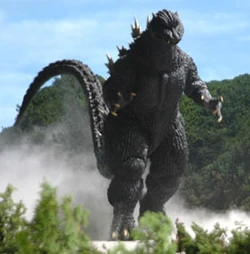
In 1954, nuclear testing awakened the monster Godzilla, the most powerful enemy mankind ever faced. The international military organization known as the Earth Defense Force (EDF) was formed to combat Godzilla and other giant monsters that appeared over the next decade, but it could never defeat Godzilla. Sometime in the 1960's, the EDF lured Godzilla to Antarctica for a final showdown. Godzilla easily defeated the EDF's Maser Cannons it had stationed there, but found himself under attack by the advanced warship the Gotengo. Godzilla shot down the Gotengo with his atomic breath, but before he could finish it he fell into a crack in the ice. Young Gotengo crewmember Douglas Gordon fired a missile at a nearby slope, causing Godzilla to be buried under tons of ice. The facility known as Area G was constructed around Godzilla's icy prison, and the monster remained trapped for decades to come.
In the year 20XX, an alien force known as the Xiliens had invaded Earth and taken control of all of the planet's monsters, using them to destroy major cities around the globe. The Gotengo, piloted by Gordon and staffed with all of the EDF's remaining forces, flew to Area G and used its missiles to free Godzilla, believing him the only force capable of defeating the Xiliens' monster army. Godzilla emerged from his icy prison, and was immediately attacked by the Xiliens' cyborg monster Gigan. Gigan wrapped Godzilla in barbed wire, but Godzilla blasted the monster's head off with his atomic breath. Believing his battle with the Gotengo from decades ago was still going on, Godzilla chased the ship to Australia. In Sydney, Godzilla found himself attacked by the monster Zilla, which lunged at him. Godzilla used his tail to smack Zilla into the Sydney Opera House, then finished his opponent with a blast of atomic breath.
Godzilla then traveled to New Guinea, where he fought Kumonga. Godzilla grabbed a thread of Kumonga's web and tossed the giant spider over the horizon before continuing on his way. After reaching the Kanto region of Japan, Godzilla encountered Kamacuras. Godzilla fired his atomic breath at the monster, which dodged the beam and flew at him. Godzilla simply grabbed Kamacuras and threw it at an electrical tower, which impaled and killed it. As Godzilla marched further inland he reached Mount Fuji, where the Xiliens deployed Anguirus, Rodan and King Caesar against him. Godzilla proved to be more than a match for the three opponents, and defeated them one-by-one, stacking their unconscious bodies on top of each other. Godzilla reached Tokyo Bay, where he was attacked by Hedorah and Ebirah. Godzilla tossed both monsters out of the bay with his atomic breath, causing Ebirah's claw to impale Hedorah's eye. With both monster immobilized, Godzilla fired his atomic breath at them and destroyed them both.
After finally reaching Tokyo, Godzilla saw the asteroid Gorath hurdling toward the city. Godzilla planted his feet and fired his atomic breath at Gorath, causing the asteroid to explode in the skies over Tokyo, reducing the city to a crater. As Godzilla stood in the ruins of Tokyo, Monster X levitated to the ground behind him. Godzilla attacked this new monster, but found it was more than a match for him, fighting with incredible speed and ferocity. Mothra flew to Tokyo to assist Godzilla, but was intercepted by the repaired and modified Gigan. Gigan sliced Mothra's wing with his chainsaw hand, then began to help Monster X fight Godzilla. Monster X held Godzilla from behind while Gigan sliced his chest with his chainsaws. Godzilla moved out of the way and caused Gigan to strike Monster X instead, causing him to release him. Mothra then flew by and knocked both Monster X and Gigan to the ground. Gigan pursued Mothra again, but was killed when his razor discs accidentally sliced his head off and Mothra flew into him and exploded. Godzilla and Monster X resumed their one-on-one battle, with Godzilla finally gaining the upper hand. Godzilla pinned Monster X to the ground and pummeled him mercilessly. When the Xilien Mothership self-destructed, Godzilla and Monster X fired their beams at each other, which locked in the air. The beams exploded, knocking the monsters to opposite sides of the city.
Suddenly, Monster X transformed into Keizer Ghidorah, which was much larger and more powerful than Godzilla. Godzilla fired his atomic breath at Keizer Ghidorah, but the creature's gravity beams overpowered Godzilla's beam. Keizer Ghidorah used its telekinetic gravity beams to toss Godzilla across the ruined cityscape, then began to kick the fallen Godzilla in the head repeatedly. Finally, Keizer Ghidorah grabbed Godzilla with hits mouths and began draining his energy. When the Gotengo flew past the monsters, its crew members realized they needed to help Godzilla. Shinichi Ozaki used the ship's Maser Cannon to fire his Keizer energy into Godzilla's dorsal plates, reinvigorating him. Godzilla released a shockwave that forced Keizer Ghidorah to release him, then destroyed the beast's middle head with his atomic breath. When another head tried to fire a gravity beam at Godzilla, Godzilla pulled the other head in front of the beam, severing it. Godzilla grabbed the maimed Keizer Ghidorah by its remaining head and slammed it up and down before throwing the monster into the air. Godzilla fired his spiral red heat beam at Keizer Ghidorah, pushing it into outer space, where it exploded.
As the Keizer energy wore off, Godzilla shot down the Gotengo with his atomic breath. As the ship's crew exited and aimed their weapons at Godzilla, Minilla suddenly ran into the city. Minilla stood in front of Godzilla, holding out his arms and blocking him from attacking the humans. Godzilla finally forgave humanity and turned around and walked out to the sea. Minilla followed after Godzilla, but not before firing a blast of atomic breath into the air. As Godzilla and Minilla waded out into the sunset, Godzilla turned and roared out one last time.
Abilities
Amphibious lifestyle
Though technically a reptile and not an amphibian, Godzilla has an amphibious lifestyle. He spends half of his life in water and the other on land. He is as adept a fighter underwater as he is on land. Capable of marching on the seafloor or swimming by undulating his tail like a crocodile, Godzilla is displayed as being able to breathe underwater, or occasionally hibernating in the ocean depths between movies.
Atomic breath
Godzilla's atomic breath, called the Incandescent Light (白熱光 Hakunekkō?) or Radioactivity Extrusion (放射能噴出 Hōshanō Funshutsu?)[6] has typically been shown to set entire city blocks ablaze and easily obliterate most military weaponry. Within the events of the 1954 film, his atomic breath was presented as a white, mist-like blast.
Durability
Starting in the first Godzilla film, Godzilla displayed an immunity to conventional weaponry, virtually impervious to everything the JSDF threw at him. Dr. Yamane states that the very fact Godzilla survived exposure to a hydrogen bomb explosion is a testament to his durability.
Anti-Godzilla weaponry
Due to Godzilla's size, super-strength and regenerative abilities, he is invulnerable to most forms of conventional attack. During the 1954 film, a powerful weapon is revealed and used upon Godzilla to finally kill him and end his reign of terror.
Oxygen Destroyer
The Oxygen Destroyer was a weapon that contained a chemical compound designed to remove all oxygen from water when put into contact with it, causing living creatures to die of asphyxiation as their remains are liquefied by the now-highly corrosive surrounding water. The Oxygen Destroyer was the first, and in many ways only, weapon to defeat Godzilla, completely disintegrating him in the original film.
Video games
Monster Strike
The 1954 Godzilla appeared within the mobile title Monster Strike as a playable character.
Godzilla: Unleashed
The infamous day that Godzilla rose from the sea to conquer Tokyo will be remembered as the beginning of the humanity's epic struggle against the reign of giant monsters.
In the Wii version of Godzilla: Unleashed, all three Godzilla incarnations are playable, each with a few differences between them, but all are fairly alike. Godzilla is simple to control, and with many different fearsome attacks, he is able to easily floor multiple monsters at once. Although his combat ability might be lacking in some regards, he still retains the deadly atomic breath ray which is an easy attack to execute and deals a lot of damage.
In the Wii version of the game, Godzilla 2000 is the only incarnation that can be played in story mode. Godzilla 1954 and Godzilla 1990's are only playable in Brawl mode, although Godzilla 1990's is playable in story mode in the PlayStation 2 version of the game.
Godzilla (2014 video game)
The first Godzilla came ashore in Tokyo and wreaked havoc in the metropolitan area as though to send a warning to the human race, which had become complacent in modern civilization. It was eventually brought down by the "Oxygen Destroyer", an underwater oxygen disrupting agent developed by Dr. Serizawa.
Later, one of the same species was identified on Iwado Island in the north and ran rampant in Japan again. However, the second Godzilla became an ally to mankind, protecting it when the space monster King Ghidorah invaded Earth.
Although it was somewhat hastily planned and produced, "Godzilla" became an explosive hit that broke through Japan's borders to an eventual release in America and Europe, where it was heralded as a fresh new take on the monster movie. The entire Showa series of 15 movies would go on to enjoy lasting popularity.
The 1954 Godzilla receives a mention within the game's kaiju guide, but isn't a playable monster within the game itself. The segments of the game taking place in 1954-era Japan replace the original Godzilla's aesthetic with that of the Heisei Godzilla.
Godzilla: Kaiju Collection
The 1954 Godzilla made an appearance within the Kaiju Collection mobile title.
Trivia
- This is the only known Godzilla to have been brown since all future incarnations of the Godzilla and its suits were charcoal black, and much later, green.
- The ShodaiGoji suit was 6.5 feet tall and weighed 200 pounds.
- In the 2002 film Godzilla Against Mechagodzilla, the ShodaiGoji design is replicated in part through CGI. Shinichi Wakasa's Monsters, Inc. also created a prop for some of the new footage of the original Godzilla.[7]
- The ShodaiGoji heavily influenced later Godzilla designs, most noticeably the 84Goji, SokogekiGoji, the 2016 design utilized in Shin Godzilla, and the updated MonsterVerse Godzilla utilised in Godzilla: King of the Monsters.
- In the film Godzilla vs. Megaguirus, the ShodaiGoji design was digitally replaced by the MireGoji in stock footage from the original film.
- This Godzilla, the Heisei Godzilla and Godzilla Filius are the only Godzillas that are confirmed to be deceased.
List of appearances
Films
Showa era
- Godzilla (First appearance)
- Godzilla Raids Again (Design, publicity stills)
Millennium series
- Godzilla vs. Megaguirus
- Godzilla, Mothra and King Ghidorah: Giant Monsters All-Out Attack
- Godzilla Against Mechagodzilla (CGI, and as Mechagodzilla)
- Godzilla: Tokyo S.O.S. (As Mechagodzilla)
- Godzilla: Final Wars
Video games
- Godzilla Generations
- Godzilla: Trading Battle
- Godzilla: Unleashed
- Monster Strike
- Godzilla (2014 video game) (Kaiju guide)
- Godzilla: Kaiju Collection
Novels
- Godzilla: King of the Monsters
References
- ↑ File:26268 Godzilla20King20of20Monsters20-Paramount20VHS20-back.jpgFile:Godzilla, King of the Monsters DVD 2002 back.jpg
- ↑ Godziszewski, Ed (December 24, 2010). Making of the Godzilla Suit! Youtube. Retrieved May 12, 2017
- ↑ Nakano, Kenji (September 27, 2014). Learning to stomp: The man inside Godzilla Tokyo Reporter. Retrieved May 12, 2017
- ↑ Hongo, Jun (October 30, 2014). Godzilla Was Very Different 60 Years Ago The Wall Street Journal. Retrieved May 12, 2017
- ↑ File:10689853 398606200295214 8421095972625706709 n.jpg
- ↑ 東宝特撮映画大全集 2012, "怪獣図鑑"
- ↑ Brett (August 12, 2011). Stopping by Monsters, Inc. Blogspot. Retrieved May 12, 2017
Template:FilmKaijuNavbox

